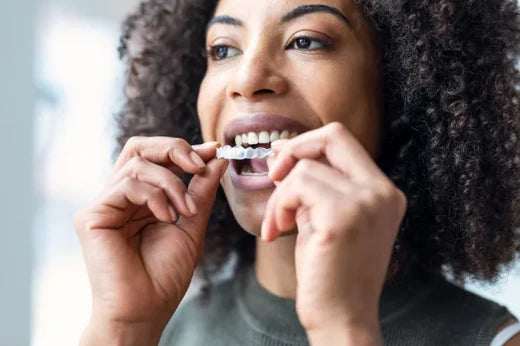
Table of contents
Invisible aligners have revolutionized the field of orthodontics in recent years. By providing a comfortable, discreet, and effective alternative to metal braces, they have become a preferred choice for teeth straightening.
These dental devices do not just help improve your appearance. But they help correct any of the bite or alignment-related issues of an individual. In this comprehensive guide, we’ll explore how invisible aligners address bite and jaw alignment issues, the benefits they offer, and why they could be your best solution for a healthy smile.
Understanding Bite and Jaw Alignment
Before delving into invisible aligners, understanding the concept of bite and jaw alignment is important.
Understanding Bite Alignment
Bite alignment refers to when your upper and lower teeth bite correctly. A properly aligned bite ensures efficient chewing, minimizes wear on teeth, and reduces strain on the jaw muscles and joints. The most common bite alignment issues include the following.
Overbite
When the upper front teeth excessively overlap the lower front teeth.
Deep Bite
When the lower front teeth extend beyond the upper front teeth.
Crossbite
When some upper teeth sit inside the lower teeth.
Teeth Gaps
The gap between two teeth is also known as a diastema.
What is Jaw Alignment?
The proper positioning of your jaws is known as jaw alignment. Poor jaw alignment could lead to different bite issues, temporomandibular joint disorders, headaches, and facial pain. A misaligned bite not only impacts the smile and facial symmetry of an individual but also affects chewing and breathing.
What are Invisible Aligners?
When it comes to invisible aligners, they offer more than just aesthetics. They are customized plastic trays that are worn on the teeth. By exerting gentle pressure on the teeth, they move them to a desirable place, fixing any jaw or bite concerns.
Benefits of Invisible Aligners
Unlike traditional braces, invisible aligners offer several benefits for a hassle-free smile journey. Since aligners have made teeth straightening effective and comfortable, it has become a preferred straightening method among individuals of all ages.
Barely Visible
Clear aligners are composed of clear plastic material, which makes them barely visible. It is an ideal way for individuals who do not want to compromise their appearance while getting their teeth straightened.
Comfortable
Unlike metal braces, invisible aligners are not fixed on the teeth. It means you do not have to undergo the hassle of metal brackets and wires on the teeth. You can simply wear aligners as per the prescribed wear time for effective results.
Easy to Remove
Since invisible aligners are not fixed on the teeth, they can be removed without the supervision of an expert. It is one of the benefits an individual looks forward to. They can enjoy their daily meals without having to worry about food sticking to wires or brackets.
Good Oral Hygiene
You can ensure your oral hygiene by simply removing your invisible aligners. Due to the presence of metal brackets and wires, oral hygiene is often compromised with metal braces. On the other hand, remove your aligners and maintain your dental health properly.
Faster Results
Invisible aligners help achieve the smile of your dreams faster than ever. Teeth straightening with metal braces takes a year or even more than that. On the other hand, the usual duration for straighter teeth with invisible aligners is just four to six months.
How do Invisible Aligners Work?
Here is a step-by-step process on how invisible aligners work.
- Initial Smile Assessment
- Impression Taking
- Treatment Planning
- Aligner Fabrication
- Wearing Aligners as prescribed
- Monitoring Progress
- Retention Phase
Tips for a Successful Aligner Journey
Consistent Wear
A clear aligner treatment has become a preferred and effective alternative to metal braces. As much as they offer a comfortable experience, individuals are required to adhere to the prescribed wear time. Aligners exert consistent pressure on the teeth to move them to a desirable spot. In case an individual fails to meet the wear time, the entire treatment is delayed.
Switch Aligners on Time
Aligners usually require changing after every 10 days. Individuals must change their aligners on time as advised by their orthodontist to ensure a steady smile journey. Use reminders or alarms to remember to change aligners on time.
Invisible Aligners - Discover The ALIGNERCO Difference

ALIGNERCO made teeth straightening effortless and affordable with invisible aligners. Having a straighter and perfectly aligned smile is more than just aesthetics. Having perfectly aligned teeth means a balanced bite and aligned jaw. If you are struggling with any of the dental misalignments causing bite issues, invisible aligners could be the right fit for you.
Why Choose ALIGNERCO Invisible Aligners?
Here is why choosing ALIGNERCO Invisible Aligners can be the key to a balanced bite and an aligned jaw.
Orthodontist-Approved Plans
Your case will be assessed by one of our smile specialists and they will guide you through the process. Further, the treatment plan is crafted and supervised by expert orthodontists.
Cutting-Edge Technology
We utilize advanced 3D technology to ensure a smooth and effective smile journey.
Affordable Treatment
Teeth straightening doesn’t have to be expensive. Get your teeth straightened affordably with ALIGNERCO Invisible Aligners.
Responsive Customer Service
Our 24/7 customer support is dedicated to assisting you whenever required. It helps to ensure a seamless aligner experience.
Final Thoughts
Invisible aligners are more than just a way to achieve a straighter smile—they play an essential role in improving the bite balance and jaw alignment of an individual. Unlike traditional braces, these clear, custom-made aligners gently move your teeth into their correct positions. They help address bite issues such as overbite, underbite, and crossbite.
By correcting misalignment, invisible aligners can alleviate strain on the jaw muscles and joints, reducing discomfort and the risk of long-term oral health complications. ALIGNERCO Invisible aligners are composed of a discreet design and a comfortable fit. They provide an effective, hassle-free solution for creating a well-aligned smile and a healthier, more balanced bite.
FAQs
1. Are invisible aligners effective for bite alignment?
Yes, invisible aligners are highly effective in correcting bite issues, including overbite, underbite, crossbite, or even a deep bite.
2. Can aligners fix jaw alignment?
Yes, your orthodontist can assess your case and suggest aligners for a perfect jaw alignment.
3. Are invisible aligners as effective as metal braces?
Yes, invisible aligners are as effective as metal braces. They exert gentle pressure on the teeth to fix bite and jaw alignment.
4. Who can get invisible aligners?
Individuals of all ages with permanent teeth can get invisible aligners. Your orthodontist can best suggest depending on the severity of your case.




